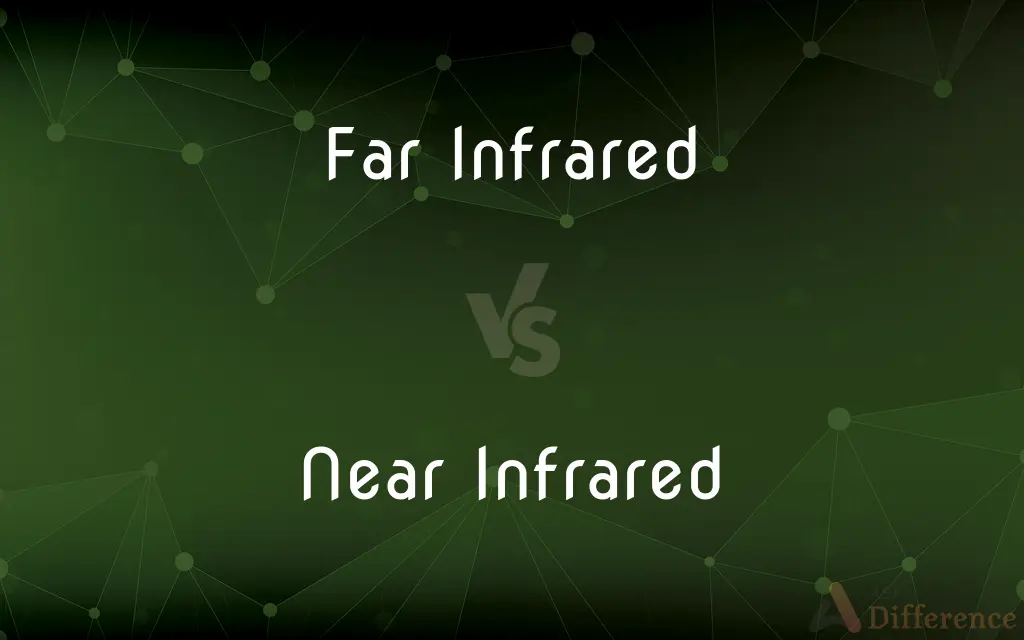Far Infrared vs. Near Infrared — What's the Difference?
By Maham Liaqat & Fiza Rafique — Published on September 12, 2024
Far Infrared penetrates deeply, promoting warmth and relaxation, while Near Infrared is absorbed more superficially, aiding in cell health and repair.

Difference Between Far Infrared and Near Infrared
Table of Contents
ADVERTISEMENT
Key Differences
Far Infrared (FIR) waves are longer and can penetrate deeper into the body's tissues, providing a gentle warmth that can enhance circulation and aid in relaxation. Near Infrared (NIR), with shorter wavelengths, is absorbed more at the skin level and is known for its potential in cellular repair and health, particularly in photobiomodulation therapies.
While FIR is often used in therapeutic settings like infrared saunas to promote deep tissue relaxation and detoxification, NIR is utilized in medical and cosmetic treatments to stimulate collagen production, promote wound healing, and improve skin health. NIR's effectiveness in these areas is attributed to its ability to stimulate mitochondrial activity and ATP production.
The absorption characteristics of FIR make it ideal for soothing muscle aches and increasing blood flow, making it popular in pain relief and wellness applications. On the other hand, NIR, due to its superficial penetration, is more effective for skin treatments and surface-level pain relief, influencing cellular repair processes directly beneath the skin.
Safety and application also differ; FIR devices are commonly designed for longer exposure times, allowing for deep tissue therapy without damaging the skin. Conversely, NIR devices are often used for shorter durations or with specific dosages in therapeutic contexts to maximize cellular response without overheating the skin or deeper tissues.
Comparison Chart
Wavelength Range
Typically 3,000 nm to 1 mm
Approximately 700 nm to 1,400 nm
ADVERTISEMENT
Penetration Depth
Deep into muscles and tissues
Superficially, primarily at the skin and muscle surface
Primary Use
Deep tissue warming, relaxation, and detoxification
Cellular repair, wound healing, and skin rejuvenation
Therapeutic Effect
Enhances circulation, relieves pain
Stimulates collagen production, promotes cellular health
Application Safety
Suitable for longer sessions in saunas or heating pads
Shorter, controlled exposures to avoid skin overheating
Compare with Definitions
Far Infrared
Electromagnetic radiation with longer wavelengths, used for deep tissue therapy.
The far infrared sauna provided deep relaxation and muscle pain relief after her workout.
Near Infrared
Absorbed by the skin's surface, influencing cellular and tissue repair.
Near infrared light reached the surface of his skin, aiding in wound healing.
Far Infrared
Able to penetrate deeply, affecting muscles and internal organs.
Far infrared rays penetrated his skin, soothing his deep tissue aches.
Near Infrared
Often used in handheld devices or panels for targeted therapy.
He used the near infrared handheld device to treat specific areas in need of recovery.
Far Infrared
Generally safe for longer exposures, used in saunas and heating devices.
He enjoyed the far infrared heating pad's warmth, knowing it was safe for extended use.
Near Infrared
Requires controlled exposure to prevent skin damage.
She followed the recommended near infrared exposure time to ensure skin safety.
Far Infrared
Commonly used for relaxation, detoxification, and enhancing blood flow.
Her regular far infrared therapy sessions helped in her overall detoxification process.
Near Infrared
Electromagnetic radiation with shorter wavelengths, beneficial for skin and superficial tissues.
The near infrared light therapy was part of her routine for skin rejuvenation.
Far Infrared
Ideal for whole-body treatments like saunas or targeted pain relief.
The far infrared device targeted her lower back, providing deep and effective pain relief.
Near Infrared
Used for skin health, wound healing, and anti-aging treatments.
Her near infrared treatment visibly improved her skin's elasticity and reduced wrinkles.
Common Curiosities
Can Far Infrared help with weight loss?
FIR may aid in weight loss by increasing metabolism and promoting detoxification through sweating.
Do Far Infrared saunas produce UV rays?
FIR saunas do not emit UV rays; they provide a safe heat source without the risks associated with UV radiation.
Is Near Infrared effective for hair growth?
NIR has been studied for its potential to stimulate hair follicle health, possibly aiding in hair growth.
Can Near Infrared damage the eyes?
Direct exposure of NIR to the eyes can be harmful; it's important to use eye protection during NIR therapy.
How often can I use Far Infrared therapy?
FIR therapy can be used regularly, even daily for some, depending on individual tolerance and health conditions.
Is Far Infrared safe for children?
FIR is generally safe for children, but exposure should be limited and closely monitored.
How does Near Infrared affect skin aging?
NIR can stimulate collagen production and cellular repair, potentially reducing signs of aging.
What materials can Far Infrared penetrate?
FIR can penetrate clothing and some materials, allowing for effective therapy through light fabric.
Can Near Infrared help with arthritis?
NIR can potentially alleviate arthritis symptoms by improving circulation and reducing inflammation at the surface level.
Does Near Infrared therapy require a professional?
While professional guidance is beneficial, many NIR devices are designed for safe home use.
Is Near Infrared good for acne?
NIR can reduce inflammation and promote healing, making it beneficial for acne treatment in some cases.
Can Far Infrared therapy detoxify the body?
FIR therapy promotes sweating, which can help in the detoxification process by eliminating toxins through the skin.
Can I use Far Infrared for facial treatments?
While FIR is safe, it's less commonly used for facial treatments due to its deep penetration.
Are Far Infrared devices expensive?
The cost of FIR devices varies, but options like saunas and heating pads can range from affordable to high-end.
Can Near Infrared improve mood?
Exposure to NIR has been associated with improved mood and energy, possibly due to increased cellular activity.
Share Your Discovery

Previous Comparison
Aluminum Wheels vs. Alloy Wheels
Next Comparison
1 Propanol vs. 2 PropanolAuthor Spotlight
Written by
Maham LiaqatCo-written by
Fiza RafiqueFiza Rafique is a skilled content writer at AskDifference.com, where she meticulously refines and enhances written pieces. Drawing from her vast editorial expertise, Fiza ensures clarity, accuracy, and precision in every article. Passionate about language, she continually seeks to elevate the quality of content for readers worldwide.













































